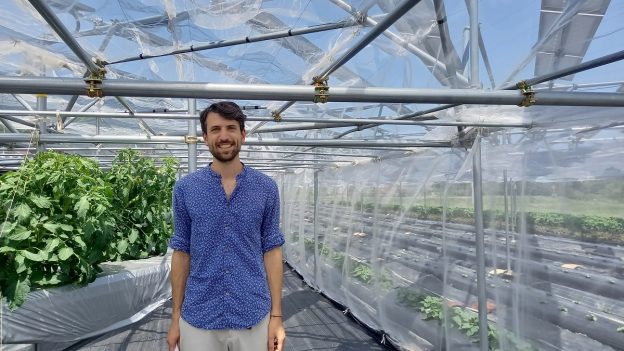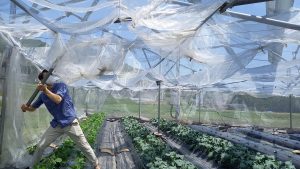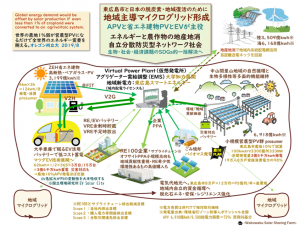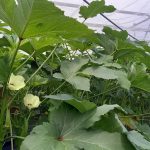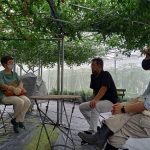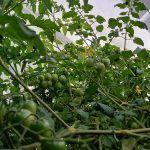On June 4th, 2022, the Waku Waku Solar Sharing Farm received the first Italian reseacher tour. Currently, he is planning to research solar sharing (agrivoltaics) at Kyoto University . Born at the foot of the Alps near Switzerland in Piedmont, northern Italy. It is a mecca for truffles and wine. After university life in Milan, now belongs to a renewable energy company in Sicily. One of the questions I received like a flood was why I accepted his visit despite the corona pamdemic disaster. About 7 years ago, I spent about 2 weeks staying at agriturismo farms in Sorrento and Salerno and Naples, Campania in Southern Italy. Since I still occasionally write travelogues of my travels on my blog, I have no choice but to gladly accept his visit. It was also a great pleasure to respond to requests from overseas to learn about solar sharing from Japan.
After asking various questions and gathering information during the two-and-a-half-hour conversation,I understood that the momentum for the introduction and research of Agrovoltaico has increased tremendously in Italy over the past two years. It seems that they are going to give it a try as a testing ground for Agrovoltaico and become a top runner in the world. A Spanish diplomat used to say, “The English think while walking. The French think before they run. The Spaniards think after they run.” As a member of the same cheerful Mediterranean culture as Spain, it seems that the momentum to start running seems to be increasing at once because it seems interesting. It reminded me of the excitement I felt six years ago when I set up our Waku Waku Solar Sharing Farm.
By the way, Italian Prime Minister Draghi as of June 2022 announced in the spring of 2021 that he would prepare 1.1 billion euros (approximately 150 billion yen) of funds to support the introduction of Agrovoltaico, expecting to install 2 GW of power plants. Perhaps because of these policy supports, the construction of a 10MW Agrovoltaico on a 22-hectare site will begin in May 2022 in Sicily, and will generate 20GWh of power annually to provide electricity for about 5,000 households. It says. Moreover, in order to make it community-based, They have adopted a scheme in which local residents invest.
The Italian government, which has begun to recognize the enormous potential of Agrovoltaico, has speeded up the time required for approval of Agrovoltaico to half that of general solar power, resulting in more than half of the approval applications for solar power in 2021. And most recently, the Minister of Agriculture and Fisheries declared its willingness to set aside a further €1.5 billion (¥210 billion) to accelerate investment in Agrovoltaico.
On the other hand, looking at Europe as a whole, the title of the conference of Intersolar Europe 2022, which will be held for three days in Munich, Germany in May this year, is Innovative Agricultural  Photovoltaic Projects and Technology. The conference itself promotes Agrivoltaics, and this year’s conference will be Agrivoltaics-focused.
Photovoltaic Projects and Technology. The conference itself promotes Agrivoltaics, and this year’s conference will be Agrivoltaics-focused.
In addition, a world conference on solar sharing (APV) called Agrivoltaics 2022 will be held simultaneously on-site and online in Piacenza, a suburb of Milan, Italy, for three days from June 15th this year. The conference will be held in France in 2020, Germany in 2021, the third time this year, and the Netherlands next year.
Well, even though I was overwhelmed by such movements, the solar sharing tour proceeded with a steady flow of questions.
◆Why did you choose Solar Sharing (APV)?
⇒Awakening to the importance of renewable energy after the Fukushima nuclear accident in 2011. Rice farming in the inherited 1 hectare paddy field is in the red all the time and it is not fun, so installing an APV was essential to maintain the farmland.
◆Why did you choose and cultivate such vegetables, and is there a decrease in yield due to shading?
⇒I like tomatoes and use them for cooking, so they are indispensable. And also It is because okra, green soybeans, broccoli, lettuce, etc. are sold relatively well at the direct sales floors of neighboring supermarkets and are profitable. I realized that with 33% shade, I could grow any kind of vegetables without any problems, so I didn’t think about choosing shade vegetables at all. I don’t really feel a decrease in yield, and tomatoes and other crops are more susceptible to heat damage at temperatures above 35°C in midsummer, which has become the norm in recent years. Humans too, of course.
Last year in Sicily there was a day of 48 degrees.
◆With the technology-related questions settled down, he asked whether it would be difficult to obtain approvals for agriculture and grid connections.
⇒The answer to this question is not straightforward. First of all, from the agricultural land regulation.
In Japan, conversion of good farmland to non-agricultural purposes is prohibited in principle. However, since 2013, as an exception to the FIT system, a system has been put in place to allow solar sharing to be installed on good farmland under strict conditions. When I asked him what the conditions were, he replied that the yield should not fall below the average yield by more than 20%, and that every three years a cultivation report with photos and an application for conversion of the stilts should be submitted. And so on, I was surprised to be answered smoothly. There seems to be a lot of research going on. What surprised me even more was that my blog on solar sharing was translated and displayed on Google, and was read in every detail. I was even more moved when I was told that the travelogue on Southern Italy included a story about Capri and a watercolor painting. You may be the most avid reader of my blog. Grazie mille! Thank you very much!
The crux of the problem is the figure of 20%. Agricultural yields fluctuate dramatically with many factors, such as climate and pest damage, and the most important influence comes from farming techniques. For example, there is a considerable difference in yield between conventional farming methods that use nitrogen chemical fertilizers and pesticides and organic and natural farming methods that use only compost and the like without pesticides. By the way, in our APV fields, we do not use chemical fertilizers, only fertilizers made from fermented rice bran and rice husks. Furthermore, there is a large difference in yield between greenhouse farming and outdoor cultivation, and there are various factors that affect yield, such as crop rotation, ridge width, crop spacing, and multi-stage cultivation. In addition, the statistical figures for the average yields of certain crops in that area have not been made public enough, and even among the published figures, there is a large disparity in actual values due to special factors. For example, the average yield of cherry tomatoes , our main crop, in this region Hiroshima prefecture is 11 tons/10a, but in Kyoto and Yamaguchi prefectures it is less than 3 tons, and our actual result last year was 3.6 tons.
When It was told that if a standardized figure like the cost rate of factory production is applied to open fields and production continues to be 20% or more less than the average yield of the region, the panel may be ordered to be removed. Unless you are a very brave person or a curious person, you will hesitate to enter the APV new market. The Agricultural Committee, which is the administrative window, will also might hope that the introduction of solar sharing will not increase due to the complexity of this decision and procedure.
Furthermore, regarding grid connection, the environment has changed significantly with the revision of the solar power generation system in 2020. In particular, new construction of small-scale low-voltage power plants of less than 50kw under FIT requires that 30% or more of the generated power be self-consumed on the spot and that disaster response is also required to continue the FIT. Few ordinary farmers can consume 30% of their own produce. Therefore, the government created a special exemption from the 30% self-consumption requirement for leading farmers who are aiming for an annual agricultural income of 5 million yen or more. As a result, it can be said that the majority of average small-scale farmers have been taken away the opportunity to seize the exciting opportunity of installing APVs that will revitalize agriculture and the region, contribute to the sustainability of the satoyama cycle, and contribute to decarbonization. The faint hope left for small-scale farmers is that the method of individual face-to-face renewable energy sales and purchase agreements based on PPAs (power purchase agreements) will become widespread, or that micro-grids can be formed in each region, enabling electric vehicle batteries to be used in households. We can only dream of a time when renewable energy can be used seamlessly with commercial power sources and microgrids to promote local production and consumption of renewable energy and provide energy for the region.
And the question finally comes to an end.
◆What do you think about the future of APV (solar sharing) ? I would like to hear your opinions on the future and challenges of solar sharing in Japan.
⇒The future of solar sharing (Agrovoltaico) is infinitely promising! I think it is full of infinite possibilities. Increasing and diversifying farmer incomes, alleviating the negative impacts of climate change on agricultural products, and contributing to energy security by decarbonizing and reducing dependence on fossil fuels in the Middle East. By promoting circulation while suppressing the outflow of local funds and revitalizing the local community, a regionally decentralized economic society will be formed and the original democratic way of thinking will take root, thereby directly contributing to the sustainable circulation of agriculture, the region, the country, and the global environment. with the addition of various synergistic effects, It draws out possibilities for an exciting future.
On the other hand, I feel very pessimistic about the future of solar sharing in Japan. Regardless of the fact that APV (solar sharing) is said to have started in Japan by Mr. Akira Nagashima of CHO Research Institute in Chiba Prefecture, In Japan, the epochmaking significance of APV is not fully understood. Or maybe there is a force to suppress it’s spreading that is beyond of my understanding.
◆I heard that Italy has decided to completely phase out its four nuclear power plants and is currently working on decommissioning them.
⇒In response to the Chernobyl accident, a referendum decided to completely abolish the system. Since then, environmental education has been thorough since elementary school, and the degree of understanding and support for the environmental activities of Sweden’s Greta Thunberg and others is extremely high. In addition to the stimulus from the Fukushima nuclear accident, the sense of crisis about climate change and the need to deal with renewable energy have increased significantly. The 2030 target for the renewable energy power supply ratio of 55% for the entire EU decided in 2019 will increase to 63% by 2030 due to the recent corona and the invasion of Ukraine .It was radically revised to achieve. In response to this, Italy’s individual target for 2030 boldly changed from 60% to 70% for the renewable energy ratio to a high target. Partly because of that, APV’s potential scale and various synergistic effects are probably attracting attention as it is regarded as a ship for migration.
By the way, Japan’s target for 2030 is 38%. There are only 7 years until 2030, but the recent rate of increase has been slowing down, and there is no sense of ambition at all. Eventhough the possibility that the enormous potential of APV may save agriculture and rural areas wiht the great transformation of renewable energy,There is no strong policy move to bet on. While APV is strictly regulated as it may lose farmland, the aging and unprofitable farmlands around it are ironically being abandoned more and more. Now, far from thinking while walking, Japan may be bedridden without thinking, walking or running. The global environment is a common property of the world, and free riding is not allowed.
EU’s renewable energy ambition is a “ wake up call ” for Japan.
Why ? A voice of sympathy said, “I think Japan has the power to do anything.”
 ◆By the way, Italy is full of tourism resources both culturally and in terms of natural scenery, but are there any criticisms or objections to renewable energy generation?
◆By the way, Italy is full of tourism resources both culturally and in terms of natural scenery, but are there any criticisms or objections to renewable energy generation?
⇒It is true that the number of UNESCO World Heritage Sites is the highest in the world, and there are naturally objections. However, in the midst of the overwhelming green shift, Agrivoltaico is rapidly attracting attention as a photovoltaic power generation method that can coexist with biodiversity and agricultural production, and can be integrated with the landscape.
In the midst of a major historical change in which the oil civilization is coming to an end, the most important thing is the awareness of the public, that is, the public opinion and the insight and decision-making ability of the political leader. Two of the most important elements seem to have disappeared from Japan in the last 10 to 20 years. Especially in the last decade, Kasumigaseki, which was supposed to be a think-tank backbone for bold problem-solving and decision-making with an eye on the future of the country, has lost its passion for free and open-minded debate and bold challenges, and has become absurdly politically driven. Mechanisms to meet it were established. Challenges come with risks, but they inspire ingenuity and a passion for the future. Reforms and challenges will not arise in societies and organizations that are afraid of failure and cannot express critical opinions freely. If you don’t do anything, you won’t fail, but now it’s an era where doing nothing leads to losing the future of not only yourself but all people.
We live in an era where we can get all kinds of information from around the world by opening the Internet. Over the past decade, Japan’s international competitiveness has declined in all fields. Above all, the English proficiency of the Japanese became the worst in the Asian region. While the world shares information across national borders for understanding and cooperating each other, only Japan is ignorant of the raw information and facts of the world falling asleep immersed in secondary information that is convenient for itself. At the very least, I would like people on the front lines of politics and policymaking to sincerely see and listen to world trends, honestly think about the country’s future prospects, and take bold action.
◆How did you study English in Italy?
⇒I have learned English since elementary school, but the Dutch and Germans speak it much better. Italians aren’t good at it, but they don’t mind making mistakes. After coming to Japan, there are many times when I have to communicate with each other by showing Google translation on my smartphone to each other. that is sad.
The second half was wet with a lot of pessimistic stories about Japan, but I’m still an optimist in the long run.
You can’t live without it.
Yes, I am an optimist too.
Let’s talk again someday while watching Agrovoltaico in Sicily, Italy.
With delicious Italian food…
Ciao! Ivan.
※Please visit another APV story in English version youtube video here.
appendix: Album of cultivated vegetables under solar panels in 2022
<June>
<July>
<August/September>
<October>

